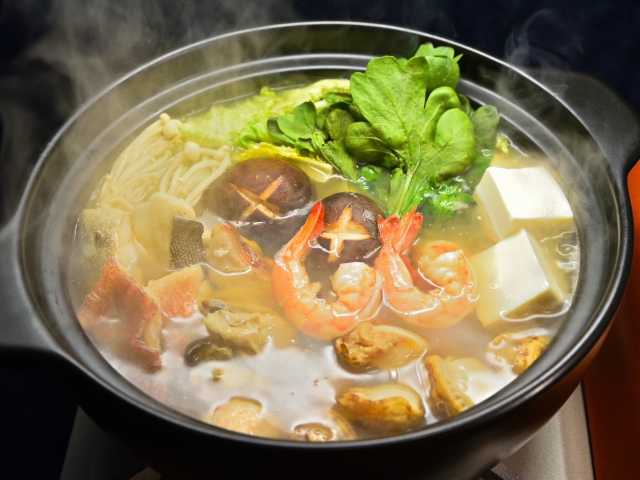News
2024.02.02
Columns
Tips for Making Your Donabe Long-Lasting

The cold weather has continued lately. What many people eager to eat on such days might be a warm hot pot meal, isn’t it? In Japan, earthenware pots named “donabe” is popular as a home kitchenware. A donabe has a higher heat storage capacity than a metal pot, lower utility costs, and is an eco-friendly product. On the other hand, there are some points to be careful about when using it.
In this column, we will introduce tips on how to use a donabe. We hope you find this column useful and enjoy using your donabe pot for a long time.
Table of Contents
1. Preparation Before Use : “Medome (Sealing)”
2. NG Things to Do
3. At Times Like This: Rescue Techniques When You are in Trouble
4. Recommendation of Rice Cook by Using Donabe
5. Conclusion
Preparation Before Use : “Medome (Sealing)”
If you’re in a situation like, “Just bought a new donebe, let’s make some hot pot dishes tonight…!”, please wait a moment. Did you know that you need to do “medome (sealing)” before using earthenware or pottery includes donabe? If you do medome, your donabe will last longer.
Earthenware and pottery have many small invisible pores, and the process of blocking these with starch is called “medome (sealing)”. If you put water in a donabe that is not sealed, the water will seep out from the bottom of it. If you use a donabe that leaks water, the stock seeps into the pot, may burn and cause stains or cracks.
The method of medome is as follows.
① Add water to the 80 percent of the pot.
② Add the starchy ingredients to ① and stir well. (Starchy ingredients can be rice, flour, potato starch, or whatever you have available. About 1 tablespoon.)
③ Place the pot over low heat and simmer for about 20 minutes.
④ Turn off the heat and let the pot cool.
⑤ Once it has cooled down to room temperature, discard the water inside and wash it thoroughly to remove the slime.
⑥ Dry thoroughly.
As you can imagine, the method of medome is not that difficult. With just a little effort, your donebe will last longer, so please give it a try.
NG Things to Do
There are some points you should be aware of when using a donabe compared to metal pots. The following are things you should not do when using a donabe.
・Put the pot in water while it is not cold.
Donabe is weak for sudden temperature changes. If you suddenly cool a hot pot with cold water, it may cause cracks.
・Leave the food and soup inside of the pot for a long.
It easily absorbs water, so leaving leftover food or juices on it can cause stains and odors.
・Use for fried food
It easily absorbs water, so if you add oil to it, it will absorb the oil. Fried or stir-fried foods are definitely not allowed, as there is a risk of ignition and fire.
・Heat up without water in it.
If you heat the donabe with no water inside, a sudden temperature change will occur and cause it to crack.
・Scrub with a metal scrubber.
This will scratch the surface and cause the starchy film sealed by medome to peel off.
・Soak and wash
This may cause stains and odors. So after using a donabe, let it cool down and wash it as soon as possible. It is also advisable to use less dish soap.
・Store undried.
If you store a donabe with undried, it may cause mold to grow.
At Times Like This: Rescue Techniques When You are in Trouble
Even if you treat it with care, it will gradually deteriorate as you use it. If you are having trouble, please refer to the following.
・Musty smell
Add 2 to 3 tablespoons of vinegar to plenty of water and boil for about 10 minutes.
・Cracked
Cook starchy foods such as porridge, rice, or flour dissolved in water.
・Concerned about the smell of food
Add a handful of used tea leaves to plenty of water, turn on the heat, and simmer for about 10 minutes.
・Burnt
Boil water with baking soda in it, let it cool, and then polish it to remove burnt marks. You should avoid using a hard scrubbing brush as it may cause damage.
Recommendations for Rice Cook by Using Donabe
In addition to hot pot dishes, donabe is also useful for cooking rice. Rice cooked in a donabe receives heat slowly, making it fluffy, chewy, and fragrant. If you cook about 2 cups, it will take only about 20 minutes to cook. (Excluding soaking time and steaming time.)
There are donabe specifically designed for cooking rice, but you can also cook rice in a flat donabe designed for hotpot cooking, so please give it a try.
Conclusion
A famous production area for donabe is Yokkaichi City, Mie Prefecture, known as Banko-yaki. In recent years, petalite, the raw material, has become rare, and it is leading to a decrease in production and a rise in prices. Future issues include how to obtain petalite and how to make donabe that do not use petalite.
Donabe is loved item for Japanese especially at the winter. Whether you are planning to purchase one or already have a favorite one, we hope that this column was something worth reading for you. And we hope that you will continue to use your donabe for a long time.
Imoto Sangyo handles various types of ceramics, kitchenware, and daily necessities.
For more information, please see the “Goods & Cases” page.
(Reference)
Japan Ceramics Wholesale Commercial Cooperative Federation
NHK Oha Biz
Category
Archive

